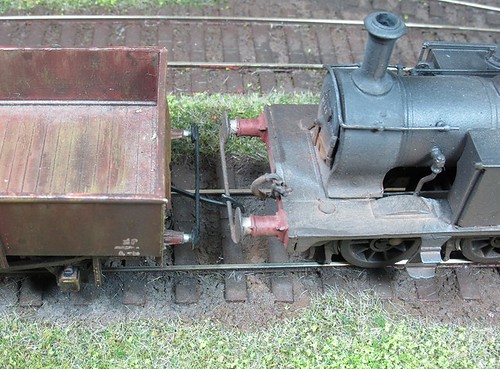A daily updated blog typed by someone with painty hands, oil under his fingernails and the smell of solder in his nostrils who likes making all sort of models and miniatures. And fixing things.
Friday, June 20, 2014
Mystery buffer bar
Mike asks: Please can you explain the use of the bar connecting the 2 front buffer pads on your Ruston shunting loco (Fri, Aug 19, 2011 blog post photo). I have Googled extensively but can't find anything to explain or show similar. Was this a real practice?
Good question. It's something I'm asked at exhibitions too and the photo you've seen doesn't give any useful clues either.
The bar is part of the Sprat & Winkle coupling system. As you can see from the pic above, wagons have both the bar and a pivoted hook on the ends. The hook grabs the bar on the loco. Basically, it's the same as a traditional tension-lock coupling you find on the ends of ready to run models except that this version is mounted upside down and operated by magnets under the track.
There's is no prototype equivalent. In real life coupling is achieved using chains attached to hooks on the buffer beam. You can do this on a model but it's very fiddly, especially in any scale under 7mm.
I've used S&Ws for many years on all my models and really like them. There are other ways of fitting the coupling rod but gluing it to the buffers is easiest and if painted with a off-black, not too obtrusive in real life.
The couplings are available from Wizard Models.
I wrote up fitting these couplings in the June 2104 issue of British Railway Modelling.
Labels:
ask phil,
model railway
Subscribe to:
Post Comments (Atom)

2 comments:
We're going to have to wait 990 years to read the article? :)
Something to look forward to!
It will be worth the wait. I've plenty of time to perfect the words :-)
Post a Comment